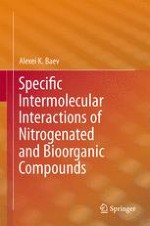2014 | OriginalPaper | Buchkapitel
2. Specific Intermolecular Interactions of Cyclic Alkylamines and Nitriles
verfasst von : Alexei K. Baev
Erschienen in: Specific Intermolecular Interactions of Nitrogenated and Bioorganic Compounds
Verlag: Springer Berlin Heidelberg
Aktivieren Sie unsere intelligente Suche, um passende Fachinhalte oder Patente zu finden.
Wählen Sie Textabschnitte aus um mit Künstlicher Intelligenz passenden Patente zu finden. powered by
Markieren Sie Textabschnitte, um KI-gestützt weitere passende Inhalte zu finden. powered by
Abstract
 . The equivalence of all six hydrogen bonds of one type and its gap in the transition of the ammonia molecule to steam allows the use of enthalpy characteristics of the corresponding process to determine the energy of the hydrogen bonds in the condensed state. It follows that the energy of the Н-bond N–H•••N is equal to the quotient of the sublimation enthalpy and evaporation of the number of realized hydrogen bonds [4–6]. The results of the calculation performed show reduced stability of the hydrogen bond, formed by the nitrogen atom of the ammonia molecule with the structure of a trigonal pyramid (4.23 and 3.86 kJ mol−1), being less stable compared with coordination of the four hydrogen atoms (6.34 and 5.91 kJ mol−1) with planar structure of the molecule in solid and liquid states, respectively.
. The equivalence of all six hydrogen bonds of one type and its gap in the transition of the ammonia molecule to steam allows the use of enthalpy characteristics of the corresponding process to determine the energy of the hydrogen bonds in the condensed state. It follows that the energy of the Н-bond N–H•••N is equal to the quotient of the sublimation enthalpy and evaporation of the number of realized hydrogen bonds [4–6]. The results of the calculation performed show reduced stability of the hydrogen bond, formed by the nitrogen atom of the ammonia molecule with the structure of a trigonal pyramid (4.23 and 3.86 kJ mol−1), being less stable compared with coordination of the four hydrogen atoms (6.34 and 5.91 kJ mol−1) with planar structure of the molecule in solid and liquid states, respectively.